Master Painterly Style: Complete Watercolor & Acrylic Course
Most artists struggle with painterly style because they approach it backwards - trying to paint 'loosely' without understanding that authentic painterly technique emerges from confidence and proper foundations, not from being careless. This comprehensive 3.5-hour course provides the complete system.

3.5 Hours of Step-by-Step Instruction for Developing Authentic Painterly Technique
Most artists struggle with painterly style because they approach it backwards - trying to paint "loosely" without understanding that authentic painterly technique emerges from confidence and proper foundations, not from being careless.
This comprehensive course provides the complete system for developing genuine painterly style, from material selection through finished complex paintings.
Course Overview & What You'll Learn
By the end of this course, you'll have the knowledge and practical experience to:
- Select the right materials that enable painterly freedom
- Develop the mental approach that creates authentic expression
- Simplify complex subjects into paintable compositions
- Execute confident brushwork in both watercolor and acrylics
- Organize values for compelling painterly effects
- Progress from simple studies to complex scenes
This isn't about painting "messy" - it's about painting with authentic confidence and expressive purpose.
Watch video course: hit play to begin your painterly journey! This isn't the typeof course you binge watch in one sitting, it's designed as a step-by-step progression. Absorb small chunks at a time, bookmark, and then return.
The art and science of mastering painterly style art
Complete Materials List
Essential Brushes
Large Brushes (Primary tools for painterly style):
- Squirrel Mop Brush #8 - For large washes and broad areas
- Squirrel Mop Brush #5 - Medium-sized shapes
- Large Flat Brush (synthetic hog bristle) - For acrylic work
- Pointed Round #12 - Versatile brush with good paint capacity
Detail Brushes (Use sparingly):
- Liner/Needle Brush - For final linear details only
- Fan Brush - Versatile for varied stroke effects
Paper Requirements
- Watercolor: 140lb watercolor paper, half-sheet (15"x22") minimum
- Acrylic: Canvas board or heavy paper, half-sheet size
- Practice: Quarter-sheet (11"x15") acceptable for studies
Working smaller than quarter-sheet forces tight technique
Palette Setup
- Large mixing area - Must accommodate your biggest brushes
- Adequate wells - For mixing substantial amounts of paint
- Travel palettes won't work - Too small for painterly brush sizes
Paint Selection
Watercolor:
- Ultramarine Blue, Cobalt Blue, Cerulean Blue
- Alizarin Crimson, Pyrrol Red, Cadmium Orange
- Yellow Ochre, Burnt Sienna, Neutral Tint, Lavender
- White Gouache (for highlights)
Acrylic (Heavy Body):
- Ultramarine Blue, Cerulean Blue
- Scarlet Red, Burnt Sienna, Cadmium Yellow
- Yellow Ochre, Titanium White
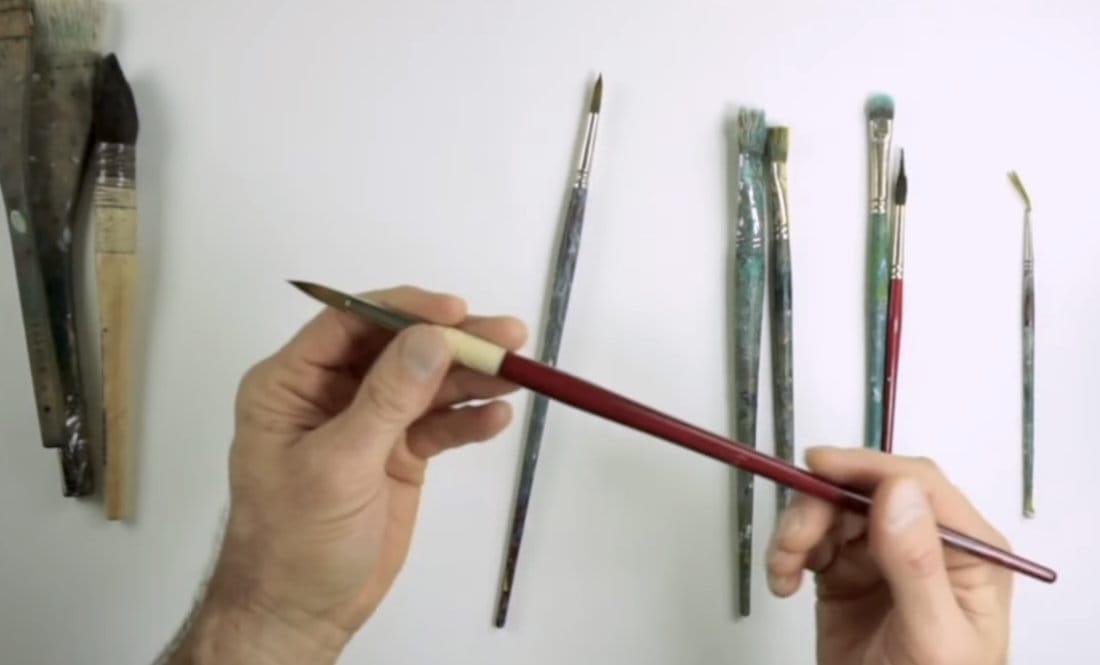
Course Curriculum
Section 1: Materials That Enable Success (0:00)
What You'll Learn:
- How brush size directly affects painting style
- Why small brushes force tight technique
- Paper size requirements for expressive freedom
- Palette setup that supports confident mixing
Practical Exercise: Brush comparison demonstration - same subject painted with different brush sizes to prove the connection between tools and results.
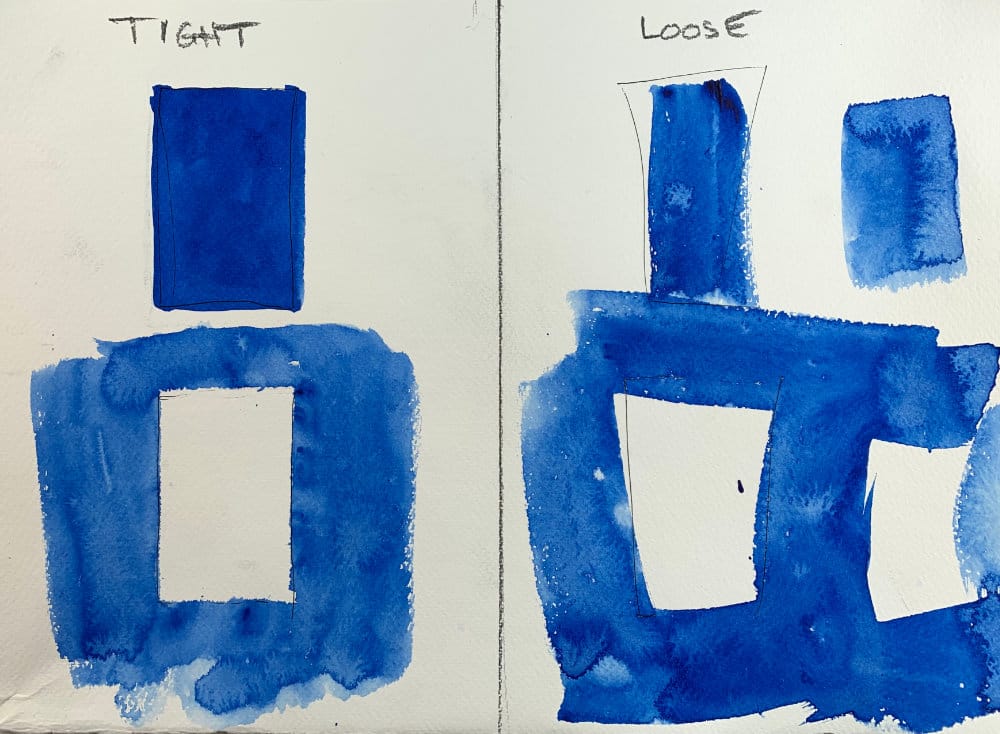
Section 2: The Attitude Foundation (23:55)
What You'll Learn:
- The coloring book psychology that keeps us tight
- Fine dining vs. pizza parlor mindset
- How childhood conditioning affects adult painting
- The mental shift required for authentic expression
The Rectangle Exercise: Two versions of the same simple shape:
- Version 1: Tight approach with death grip, many corrective strokes
- Version 2: Confident approach with relaxed grip, single decisive strokes
This exercise alone transforms how students approach every mark they make.
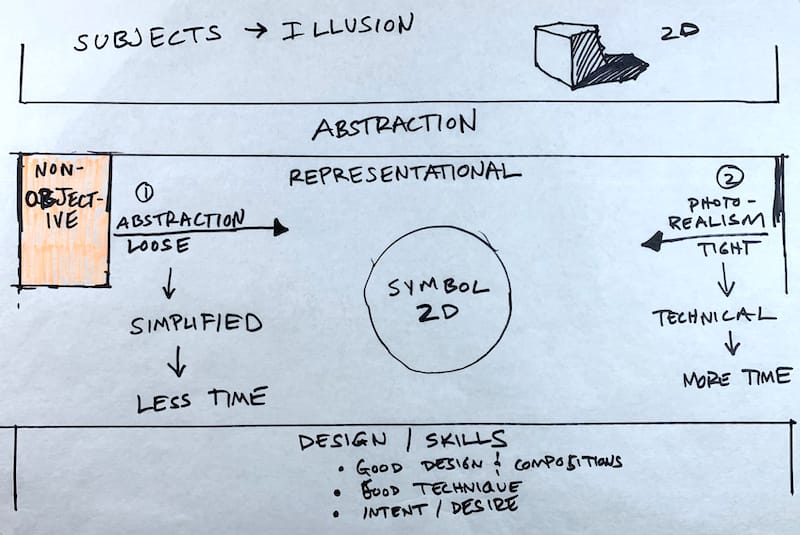
Section 3: Understanding Painterly Style (30:45)
What You'll Learn:
- The three types of art: non-objective, abstraction, and photorealism
- Where painterly style fits in the spectrum
- Why everything you paint is actually "abstract"
- The role of simplification vs. detail
Key Insight: Painterly style isn't about being imperfect - it's about confident expression through suggestion rather than exhaustive rendering.

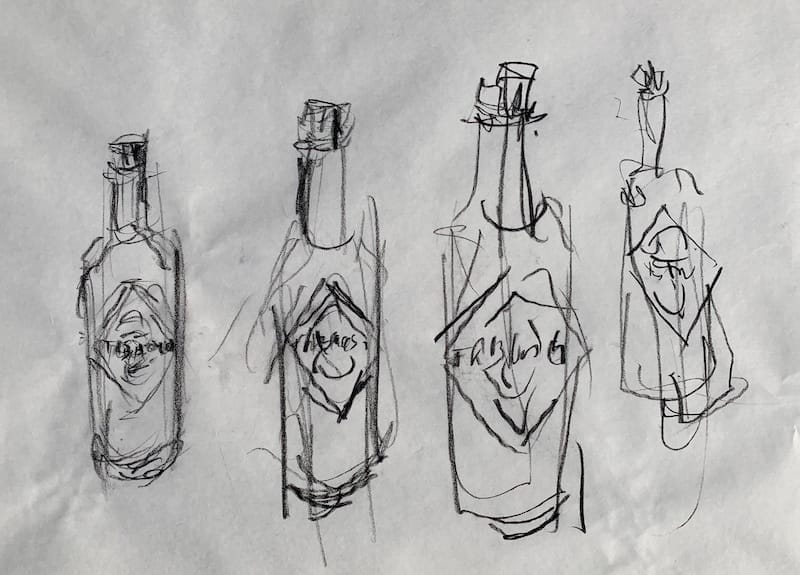
Section 4: Simplification Techniques (46:27)
What You'll Learn:
- How to see essential shapes in complex subjects
- Eliminating details that don't serve the painting
- The art of suggestion vs. rendering
- Working from general to specific
Hands-On Demonstration: Tabasco bottle study
- Three levels of simplification shown
- Same subject, different amounts of detail
- How color adds information you don't have to paint
Section 5: Brush Handling for Painterly Effects
What You'll Learn:
- Proper brush grip for expressive work
- How handle position affects stroke quality
- Loading brushes for maximum coverage
- When to hold back vs. move forward on the handle
Practice Methods:
- Minimum stroke exercises
- Planning approach before paint touches paper
- Working wet-into-wet for organic effects
- Dry brush techniques for texture
Section 6: Value Organization
What You'll Learn:
- Reducing complex scenes to 3-4 value masses
- How proper value structure enables loose technique
- Creating depth through value relationships
- When to simplify vs. when to add complexity
Value Study Process:
- Thumbnail sketches for composition
- Simple value studies using 3 tones
- How values guide brush selection and paint application
Section 7: Watercolor Demonstrations
Simple Subject Study:
- Single object approach (Tabasco bottle)
- Wet-into-wet techniques
- Color mingling and controlled accidents
- When to leave areas alone
Complex Scene Approach:
- Street scene demonstration
- Working background to foreground
- Maintaining large value masses
- Adding details without destroying painterly quality
Section 8: Acrylic Demonstrations
Layered Approach:
- Same subjects as watercolor using acrylic methods
- Building up paint in confident layers
- Working without preliminary drawings
- How acrylics enable different painterly effects
Mixed Media Integration:
- When and how to combine mediums
- Maintaining painterly approach across materials
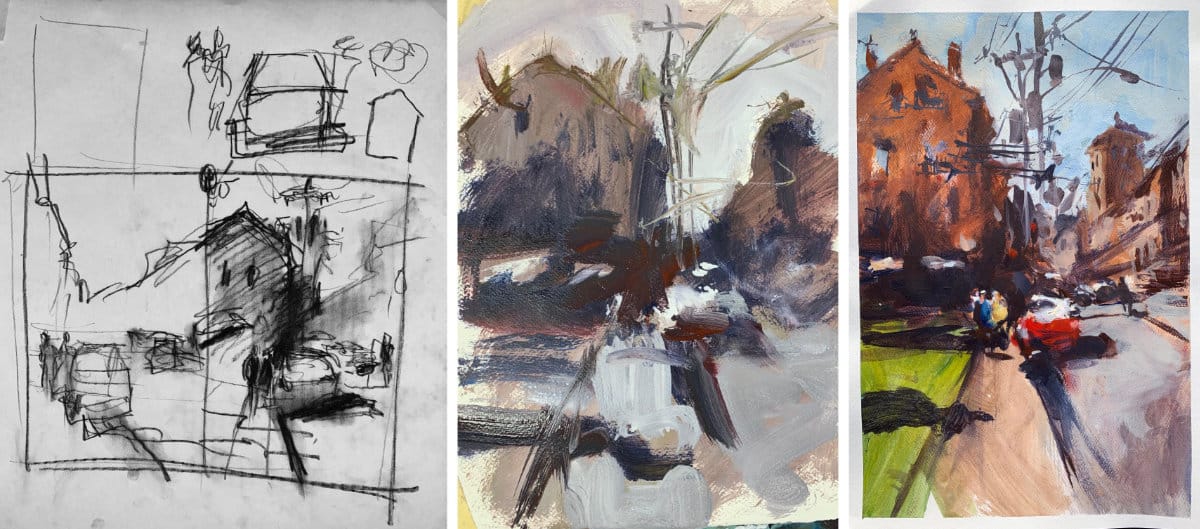
Section 9: Complex Scene Simplification (1:48:53)
What You'll Learn:
- Breaking down overwhelming reference photos
- Finding the story within complex information
- Design decisions that support painterly execution
- Working from inspiration rather than copying
Complete Painting Process:
- Initial sketches and planning
- Value organization
- Step-by-step painting execution
- When to stop vs. when to refine
Practice Exercises (Work Along with Video)
Exercise 1: Rectangle Studies
Create both tight and loose versions to experience the difference in approach and results.
Exercise 2: Single Object Studies
Paint the same simple object (bottle, apple, etc.) three times with decreasing amounts of detail.
Exercise 3: Value Mass Studies
Reduce a complex photo to 3-4 simple shapes, paint them confidently.
Exercise 4: Brush Size Comparison
Paint the same subject with different brush sizes to prove the connection between tools and technique.
Exercise 5: No-Drawing Paintings
Simple subjects painted directly without preliminary sketches.
Learning Progression
Beginner Level: Start here if you typically paint tight or are new to painterly approaches
- Focus on attitude and materials sections
- Practice rectangle and single object exercises
- Master brush handling basics
Intermediate Level: You can paint competently but want more expressive freedom
- Concentrate on simplification techniques
- Practice value organization methods
- Work through both watercolor and acrylic demonstrations
Advanced Level: You paint confidently but want to refine painterly approach
- Focus on complex scene simplification
- Develop personal methods for subject interpretation
- Experiment with mixed media applications
What Makes This Course Different
Based on Real Studio Experience: Every technique comes from 16 years of daily painting and teaching, not art school theory.
Focuses on Mindset: Technical skills without the right mental approach lead to tight, careful work that misses the point of painterly style.
Material-Specific Guidance: Understanding how your tools affect your results eliminates frustration and wasted effort.
Progressive Skill Building: Each section builds on previous learning, creating a complete system rather than random techniques.
Honest About Challenges: Painterly style requires embracing imperfection - this course prepares you mentally and technically for that shift.
Course Materials Access
Video Length: 3.5 hours of instruction Format: HD video with close-up demonstrations Bonus Materials:
- Printable materials list
- Reference photos used in demonstrations
- Value study templates
Expected Outcomes
After Section 3: You'll understand why you paint tight and have practical methods for loosening up.
After Section 5: You'll select brushes purposefully and handle them for expressive results rather than careful control.
After Section 7: You'll complete watercolor paintings that show authentic painterly qualities - confident brushwork, effective simplification, expressive color handling.
After Section 9: You'll approach any subject with a systematic method for creating painterly interpretations rather than tight copies.
Course Completion: You'll have internalized the mindset, methods, and technical skills needed for authentic painterly style in both watercolor and acrylics.
This course provides the complete foundation for painterly style - from proper materials through finished complex paintings. Every lesson builds toward developing the confidence and technical ability to create authentic expressive work.
👉 Want more drawing lessons? Visit the Free Drawing Tutorials & Courses hub
👉 If you’re brand new, you can start at the Acrylic Hub — it’s got all the free courses and guides in one place.
👉 Discover more mixed media painting techniques in my Mixed Media Hub
👉 Want step-by-step lessons? Visit the Watercolor Hub for tutorials and free courses.
Here are the materials I use all the time and have for decades. I only buy from Blick Art but feel free to shop where you prefer.
Recommended Watercolor Materials
-
Holbein Professional Watercolor Paints – 8 Essential Hues
Yellow Ochre, Cadmium Lemon Yellow, Ultramarine Blue, Cerulean Blue, Alizarin Crimson, Cadmium Red Light, Neutral Tint, Burnt Sienna -
Fabriano Artistico Watercolor Paper – 140lb Cold Press
Buy full sheets and cut into quarter sheets for best value -
Silver Jumbo Wash Brush
Great coverage, excellent quality for the price -
Princeton Neptune Point Rounds (No. 12 & 6)
Reliable and affordable detail & wash brushes -
Princeton Neptune Dagger (1/2")
Versatile size for lines, edges, and detail work -
Masterson Aqua Pro Palette
Durable, with deep wells for generous mixing space -
Gator Board
Lightweight, long-lasting painting support board -
Holbein White Gouache
Optional for highlights and fine details - Miscellaneous: plastic water containers, paper towels, masking tape
Recommended Acrylic Painting Materials
-
Princeton Catalyst Brushes – Flats (#6, #12), Rounds (#4, #8), Fan (#4), Liner Brush
Durable synthetic bristles for versatile acrylic techniques -
Liquitex Heavy Body Acrylic Paint – Essential Colors
Cadmium Yellow, Yellow Ochre, Alizarin Crimson, Cadmium Red Light, Ultramarine Blue, Cobalt Blue, Burnt Sienna, Titanium White -
Winsor & Newton Cotton Canvas
Reliable stretched canvas for studio and plein air work -
Strathmore 400 Series Mixed Media Paper
Heavyweight, acid-free paper for acrylic and mixed media -
Fabriano Artistico 140lb Cold Press Paper
Excellent for acrylic, mixed media, and textured effects -
Blick Multi-Colored Painting Knife Set
Variety of shapes for texture, scraping, and bold strokes - Miscellaneous: Two pint-sized water containers, paper towels (from Home Depot or Walmart)
- Note: I use canvas or sturdy cardboard as my palette — no store-bought palettes needed.




